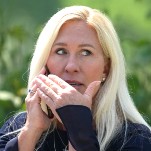Mom, I Have Two Boyfriends: How I Discovered I Was Polyamorous at 27
LatestAlmost every girl has a movie that breaks her. It’s usually something intended for children, like Cinderella. The girl watches it and gets hooked on this idea that if she has an impossibly tiny waist and can talk to birds, eventually she’ll stumble upon the man of her dreams. He’ll put her in a carriage, and for some reason she’ll be into that.
Honestly, I didn’t buy the fairytale trope. Never did. I mean, talking to birds? Massive royal galas? I was much too much a realist. For me, the movie—the one that broke me—came much later. It disguised itself better as a story that could actually happen, so at 12, I drank the Kool-Aid.
The movie was Bed of Roses, starring Christian Slater and Mary Stuart Masterson. You might remember it from when you went to the video store in the ’90s and saw it and said, “Hey, what’s that movie that looks exactly like American Beauty?” Here’s the premise: Girl is an emotional minefield because her family was psychologically abusive. Boy is a sad, hot, widowing florist. Boy sees girl while he’s on one of “these walks he takes at night.” She’s at her apartment window—apparently the only lit apartment window in all of Manhattan—and she’s crying. Boy sends girl random flowers. Boy and girl fall in love. Boy fixes girl. The end.
I absolutely loved this movie. I loved how delicate and sad Mary Stuart Masterson was; how she so believably had built “emotional walls” to prevent the pains of falling in love. I loved how Christian Slater could somehow afford a rooftop rose garden to have sex on, but only if it was with Mary Stuart Masterson. (And maybe his ex-wife, who died a LONG time ago, and whom he had of course mourned appropriately.) I loved how at the end, after the requisite movie misunderstanding, Mary Stuart Masterson is leaving Christian Slater’s apartment, about to give up on their love, and he says, “Wait, don’t go.” These triumphant, slow violins begin to play before they kiss.
I loved all of it. I knew then what most girls know at some point in their life: all I wanted, more than anything, was to be found, rescued, and loved forever.
A little over a decade later, I had been in six long-term, serious relationships. By “long-term” I mean that they lasted over a year, and usually almost exactly a year and a half. By “serious” I mean that marriage was discussed in every one of them—including the first one, when I was 16. I couldn’t stand the idea of being in a relationship that didn’t have the potential of being my Bed of Roses relationship. The boys I dated were almost all wonderful—they were all “husband material,” as my mother put it—but something always went wrong and they all ended. By the time I was in my mid-twenties and still not married with a dog in the yard and a kid on the way, I was pretty annoyed.
Then I got into the relationship that I was absolutely sure was The One. It was one of those relationships where we mutually crushed on each other for a while, and then there was this perfect summer kiss on a grassy hill in the sunshine, and then everything proceeded to go flawlessly. Every day I spent with this guy was perfect; we never fought; we both liked alone time; we ate the same foods. He even watched Glee with me that year I was really into Glee, and I read the weird gross-out comics he was into that made me a little nauseous. I’m telling you: this was the perfect relationship. I had wedding invitations planned out.
And then, all of a sudden, it ended. Nothing had really seemed to be wrong, and then suddenly something felt wrong to him, and eventually he told me that he couldn’t pretend anymore, and the relationship ended. I just sat there, watching my Bed of Roses fantasy crumble, and the world as I knew it came to a grinding halt.
I spent a LOT of nights alone in my room watching Gilmore Girls for a while, muttering statements that included the phrases, “alone forever,” and “lots of cats.” What had gone wrong? How had this perfect relationship broken? Where was Christian Slater when I needed him?
-

-

-

-

-

-

-

-

-

-

-

-

-

-

-

-

-

-

-

-

-

-

-

-

-

-

-

-

-

-

-

-

-

-

-

-

-

-

-

-








































